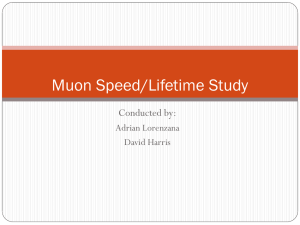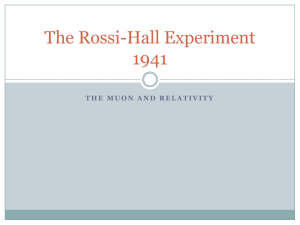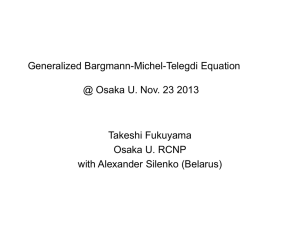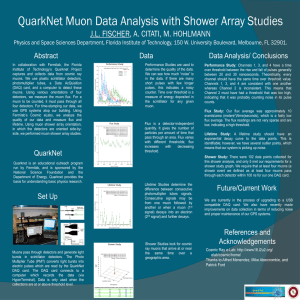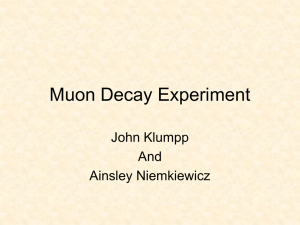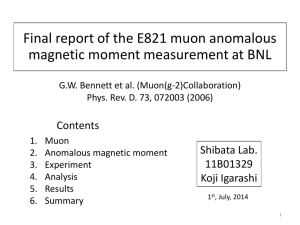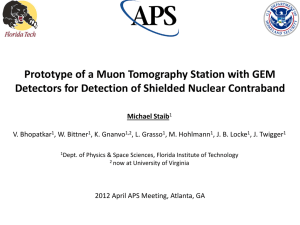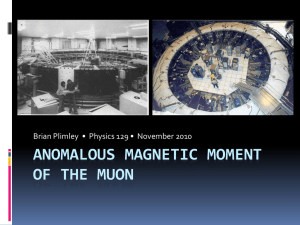11. Alexander Managadze Muon radiography
advertisement
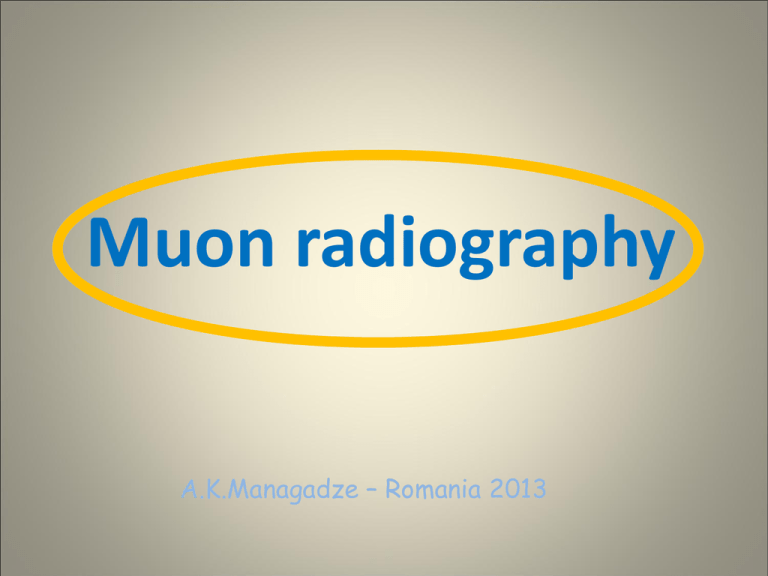
Muon radiography A.K.Managadze – Romania 2013 General muon features Muon (μ) is a light charged elementary particle with spin ½ belonging to leptons. Many characteristics of muon and electron are similar, but the muon mass (106 MeV) is 207 times more than the electron mass. Therefore the muon path length is thousands times longer than for electron. Muon lifetime is around 2.2 μs. Muon penetration ability Muons penetrate through the planet surface with intensity 10 000 particles/(m2∙min) and therefore through everything situated upon Earth. Even at rather moderate energy 10 GeV muons are able to pass not only complete Earth atmosphere, but to penetrate deep into the ground. Maximal depth, where highest energy muons were detected, was about 8600 m of water equivalent. Muon radiography uses the same main concepts as medical radiography: beam absorption (muons instead of X-rays) while passing through matter (rock or building materials instead of human flesh) and a sensitive device. Advantages of the method are its noninvasiveness and employment of natural origin of radiation. Muon radiography in archaeology. For the first time the idea of CR muon flux application for detection of density fluctuations in the structure of archaeological objects was arised about 40 years ago due to Luis Alvarez. This idea was employed for sectret chamber search in Chephren pyramid. Muon flux inside pyramid was measured by streamer chambers. More than million events were detected by 2 streamer chambers with area 1.8 m2 each. Researchers determined the absence of secret cavities in the pyramid body. The Luis Alvarez 1970 muon experiment Chephren Pyramid Results from the Luis Alvarez experiment Chephren Pyramid Observed Simulation with a chamber Muon radiography in volcanology Cosmic-ray Photograph of a Volcano (Showa-Shinzan) 1dot=1muon Angular space distribution Profile of Asama mountine showing geometrical location of the measuring detector. Data o muons from opposite flux were also used for confirmation of detector efficiency and of muon flux isotropy. The detector was fixed in underground cave to cancel the background from other particles. Radiographycal image of volcanic crater under dome lava. Left – lava dome map and muon detector position. Right – volcano appearance and the distribution of rock density in vertical plane. (Elevation in m). Industrial objects radiography. Muon tomography method can be used also for inspection of the conditions of huge industrial objects (bridges, dams, blast furnaces and so on), when it is necessary to estimate technical state or safety of such bodies (for example, crack appearance, internal construction conditions, groundwater level and so on). Radiography when manipulating with nuclear materials. Since muons are highly penetrating and sensitive to materials with high Z (with large charge of atomic nucleus, in particular nuclear materials), muon radiography began to develop as effective method of detection of such inclusions in packed cargo and loads. Disposition of borehole and underground gas storage as an example of muon radiography opportunity Muon tomography can be applied for inspection of interrior conditions of nuclear objects (reactors) while their malfunction or other impossibility of measurements Left ― possible detector location while reactor tomography and muon trajectories. Right ― angular scan of muon tomography results after exposition 7 m2·day (the reactor core is distinguished and no big damage is seen). Muon radiography for exploration of Mars geology Operational concept. Muons generated by interactions of primary cosmic rays in the planet’s atmosphere (green spheres) pass through a geologic object of interest, and are partially absorbed by the object. A passive muon detector composed of parallel scintillating plates on a lander or a rover records the tracks of the muons. The recorded tracks are analyzed on site to determine the direction from which they entered the detector and the amount of energy absorbed by the target. The observations are distilled into a density image of the geological target, much like an X-ray radiograph would, except using muons as a passive source of radiation. Two concepts are presented: (A) Muon radiography instrument mounted as a secondary instrument on a rover. (B) The instrument is mounted on a small Phoenix class lander observing multiple targets during the life of the mission. Potential primary target for muon radiography exploration on Mars. Complex terrain of collapse structures on the lower flanks of Arsia Mons, Mars likely contains lava tubes and caves in the subsurface. Muon radiography obtained from trough floors could be used to map the void space associated with partially collapsed lava tubes. Employment of nuclear emulsions as detectors for muon radiography. Beyond high space and angular resolution track detectors on the base of nuclear emulsions are very suitable for muon radiography due to their information capacity, easy transportation and rather simple operation under the conditions of unfavourable environment. Moreover emulsions do not need energy supply and electronic reader device. Muon radiography test-2012 of nuclear emulsion detector method (2012, P.N.Lebedev Physical Institute, RAS and D.V.Skobeltsyn Institute of Nuclear Physics, MSU): Emulsion stacks were inserted within the body of steel metal column (around 3 m height) of SINP MSU accelerator frame and outside Steel column being the part of accelerator frame Exposition – 49 days The weight of this steel column is about 23 tonnes Metal column of the accelerator frame Test experiment on muon registartion - 2012 Scheme of detector location Prepared stacks of emulsions and aluminium plate with fixed stacks 1 3 2 Structure of emulsion stacks: 1. “Slavich” emulsion ― 3 single layer emulsion plates + metal plate + 3 single layer emulsion plates. 2. Fuji-OPERA emulsion ― Changeable sheet stack + metal plate + Changeable sheet stack (12 layers in total). 3. Fuji-OPERA emulsion ― 4 emulsion layers. А) Схема эмульсионной стопки, размещенной в теле стальной колонны Б) Схема эмульсионной стопки, размещенной сбоку от стальной колонны. Arrangement of emulsion stacks into metal column Estimations and expected results of the test Assumptions: I(E>0.3 GeV)≈7·10-3 cm-2sec-1sr-1 Effective zenith angle range ― 30o Exposition duration ― 49 days Then Ilocal outside/Ilocal underFe ≈ 10 Microscopic stage in MSU with nuclear emulsion plate Comparison of muon angular distributions at various azimuth angles φ and fixed zenith angle = 21.6о in model calculation and in the test experiment itself, presents experiment results with background deduction for 2 months assumption. TEST-2012 RESULTS Spatial distribution of muon fluxes measured in this test experiment and calculated nonuniformity caused by huge solid absorber (column) agree rather satisfactory. That shows muon radiography capability. It is necessary to take into account, that some procedure corrections in experiment realization are required. Muon radiography test – 2013 of nuclear emulsion detector method (2013, P.N.Lebedev Physical Institute, RAS and D.V.Skobeltsyn Institute of Nuclear Physics, MSU): Emulsion stacks were placed near two huge steel disks in the building of industrial plant in Moscow. Two huge solid steel disks for tyre trial in industrial factory Test-2013 experiment scheme The weight of such steel disk is about 40 000 kg Location of emulsion stacks in Test-2013 In this test-2013 2 emulsion stacks were disposed horizontally and 2 emulsion stacks were disposed with slope 45o at some distance from massive objects. Exposition will be continuing longer than 4 months. We hope to elaborate procedures of such data treatment and extraction of the object image. Thank you for regard A.K.Managadze – Romania 2013 Muon spectrum measurement Appearance and structure of multilayer X-emulsion lead chamber in MSU experiment Differential energy spectra of muons: а — for horizontal flux of muons, б — for vertical flux. • — MSU experimental data (1994), ○, х, □ — results of other authors 1984-1985); Solid line — calculation of muon flux with charm generation, dashed line — calculation without charm generation. Предпосылки использования мюонной радиографии. Мюонная радиография базируется на хорошо известном спектре мюонов космических лучей, приходящих под различными зенитными углами, а также на разработанной модели прохождения мюонов через вещество. При этом освоена методика работы детекторов мюонов. Энергетический спектр мюонов космических лучей, приходящих под разными углами. Эксперимент DEIS (Allkofer et al., 1981) и модельные расчеты для больших углов . Поток мюонов КЛ при разных зенитных углах, проникающий через толщу скалы с плотностью 2.5 г/см3. Facilities of geological exploration Measurement of CR intensity by detectors in a tunnel and comparison of obtained data with conventional dependence of CR absorption in water or in ground can give information about ore layers and interstices or enable to determine weight load upon ground from installations above. Progress in muon radiography was enabled by progress in measurement methods: introduction of electron stripped detectors and ultraspeed scanning microscope for emulsion handling. Emulsion technique has advantage in cost, does not need electric supply, and the application of fine-grained nanoemulsion provides higher angular resolution. The example of minerals exploration with measurement of muon CR copmponent. а — profile of polimetalic field (I — alluviums, II — limestone, III — rich ore, IV — poor ore, V — impregnated ore); b — cosmic ray intensity I measured by detector telescope. Расположение газохранилища и изолинии топографии местности The Vesuvio muon telescope site Telescope location What we aspect to see * Rivelatore

